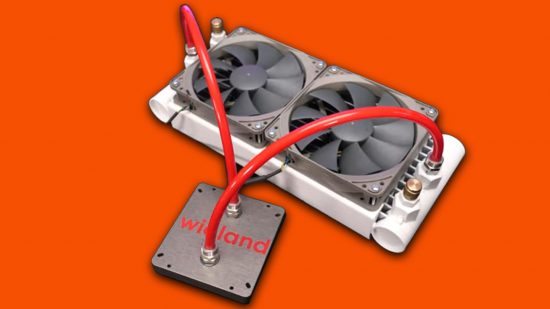One of the chief downsides of all-in-one liquid CPU coolers is that the pumps can be somewhat noisy, plus they can be prone to failure. That’s why we’ve seen several attempts at creating self-circulating, pumpless AIO coolers over the years, but this new pumpless AIO CPU cooler is the best attempt we’ve yet seen.
Made by a company called Wieland, this prototype cooler isn’t yet worthy of a spot on our best CPU coolers list but has shown potential to be a viable alternative to traditional water-cooled, pump-circulated coolers.

The cooler, which has been tested by hardware specialist YouTuber, der8auer, looks almost identical to a traditional 240mm AIO cooler, with a 240mm radiator for dissipating the heat and two tubes connecting to a metal plate that sits on top of your CPU. There are only really two giveaways as to this being a cooler that’s a bit different.
Firstly, there’s the fact that the two tubes attach to either end of the radiator, rather than connecting at the same end. To us, this suggests that this configuration is required to take full advantage of the heat differential across the radiator to keep coolant flowing through it, rather than relying on a pump to force coolant around the radiator and back out the same side.
The second difference is that the CPU heat plate (dubbed the Wieland cold plate) – which interestingly appears to be solid aluminum rather than copper – is only around 10mm thick, clearly showing there’s no room for a pump inside. Not only does this make for a very sleek-looking, low-profile installation but it hints at the secret sauce for how this cooler works.
Instead of using a pump, then, this prototype Wieland cooler seems to use either a single or dual-phase system whereby heat added to the CPU plate warms a liquid and either causes it to circulate due to the temperature difference (single-phase) or causes it to evaporate then condense as it cools in the radiator (dual-phase). The latter is how heat pipes and vapor chambers work, as used commonly in traditional ‘air’ CPU coolers and GPUs.
Currently, Wieland isn’t revealing what the liquid is or how the cooler actually works. This isn’t a surprise as, if successful, there’s significant potential for Wieland to patent the solution and charge other manufacturers for rights to use the design – something Asetek has done to great affect by owning the patent to traditional pump-in-CPU-block AIO designs.
In their tests, der8auer found the Wieland cooler was around 8-10°C hotter than a conventional 240mm liquid cooler (although, it was actually a 360mm radiator but with two 120mm fans, which may have skewed the data). As such, it’s not outperforming existing solutions as yet. However, der8auer identified that the gap between the fans and radiator was quite large, potentially reducing the amount of airflow forced through the radiator. They also pointed out a switch to using copper in the CPU plate could further boost cooling.
As for the advantages of this cooler, they’ll mainly come down to two things: reduced noise and longer life. Although you’ll still need to use fans, the lack of a pump makes for one less source of noise. Meanwhile, pumps can fail and leak, so this cooler could last much longer than pumped designs, assuming the coolant doesn’t tend to leak, off-gas, or react with or clog up the piping. If heatpipes are anything to go by, this cooler could last many, many years without issue.
This cooler could see a revolution in how to build a gaming PC but we’ll have to wait a while, as this cooler is only a prototype for now, though we wouldn’t be unhappy if it keeps its retro red-piped, white-radiator design.
